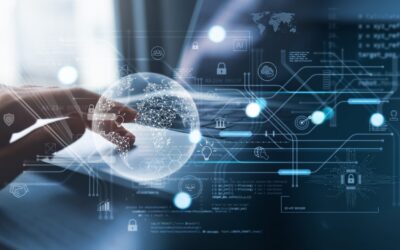Google’s Cybersecurity Forecast 2026 highlights a reality every organization must confront: AI is changing the threat landscape faster than most security programs can adapt. Attackers are scaling operations with automation, nation-state activity is intensifying, and traditional defenses are losing effectiveness in the face of AI-powered deception and velocity.
(Help Net Security, Nov 5, 2025)
For security leaders, 2026 isn’t a gradual shift — it’s a year where AI becomes central to both the attacks we face and the defenses we rely upon. The organizations that succeed will be those that modernize governance, elevate identity security, and build resilience into every part of their cybersecurity program.
AI Accelerates Attacks — And Expands the Attack Surface
AI is now a daily part of attacker workflows. That means organizations must rethink their assumptions about speed, detection, and trust.
Prompt Injection Becomes a Mainstream Enterprise Threat
Prompt injection attacks, where adversaries manipulate an LLM’s context to override its safeguards, have become one of the fastest-growing attack vectors Google identifies.
Unlike traditional vulnerabilities tied to code flaws, prompt injection exploits logic, context, and trust — elements most enterprises are not monitoring.
As more organizations embed AI into email triage, IT ticketing, customer support, DevOps workflows, and security operations, the consequences of a poisoned prompt become more severe. Significantly, a single manipulated AI agent can now:
-
Alter system settings
-
Generate fraudulent approvals
-
Leak sensitive data
-
Execute unintended automation
-
Circumvent compliance guardrails
Basically, these are not future risks — they are active threats to any organization deploying AI without proper context controls.
AI Makes Social Engineering More Convincing — and More Scalable
Google highlights how cybercriminals are now using AI to outperform traditional phishing techniques. Groups like ShinyHunters are deploying AI-generated voices to impersonate executives or IT staff, removing the telltale signs employees rely on to spot fraud.
This evolution moved social engineering from opportunistic to highly targeted and emotionally realistic. Attackers no longer need to bypass technology when they can simply persuade a human.
Organizations must respond by updating their awareness training, MFA policies, and identity verification processes to address AI-driven psychological manipulation.
AI Agents Introduce New Identity and Access Risks
Google warns that organizations will soon rely on autonomous AI agents for task execution.
So, these agents will need:
-
Distinct machine identities
-
Task-based privilege
-
Permissions that expire automatically
-
Continuous monitoring for abuse
Traditional IAM solutions were designed for humans — not algorithms making rapid decisions across cloud platforms.
Without governance, AI agents introduce new opportunities for privilege escalation, data exposure, and unauthorized transactions.
This is where security teams must align AI adoption with strict identity frameworks, segregation of duties, and auditable control points.
Shadow AI Creates Internal Blind Spots
Shadow AI — the growing use of unsanctioned AI tools by employees — is quickly becoming one of the most significant internal risks.
When workers copy sensitive information into free online models or rely on unsanctioned apps to generate documents, analyze spreadsheets, or summarize data, organizations lose visibility and control.
Explicitly, Google stresses that banning AI outright only drives this behavior underground.
Organizations must instead:
-
Provide approved AI tools
-
Define clear usage policies
-
Monitor for unauthorized activity
-
Train employees on data handling risks
Shadow AI is not a technology problem — it’s a governance and culture problem. And without proactive leadership, it can quietly create major data exposure events.
Cybercrime Surges in Scale and Sophistication
Google’s forecast underscores that AI is accelerating not just how attackers operate, but how many victims they can reach at once.
Ransomware, Extortion, and Data Theft Converge
In Q1 2025, more than 2,300 victims were named on leak sites — the highest number ever recorded. This surge reflects the shift toward triple-layer extortion:
-
Encrypt systems
-
Steal data
-
Pressure victims through leak threats and public exposure
Thus, as AI increases the speed of reconnaissance, access discovery, and content generation, these operations become more efficient and more aggressive.
Zero-Day Exploitation and Supply Chain Attacks Continue to Rise
Google notes that attackers are increasingly leveraging zero-day vulnerabilities and software supply chain weaknesses — enabling them to hit hundreds of targets simultaneously.
Unfortunately, this ripple effect reinforces the need for continuous vulnerability risk management, third-party risk assessments, and strict vendor governance.
Blockchain and Virtualization Become Key Battlegrounds
Cybercriminals are using blockchain systems to obfuscate stolen assets, making investigations more complex. At the same time, adversaries have begun targeting hypervisors, where compromising a single virtualization platform can disable hundreds of workloads at once.
Google’s guidance is clear: organizations must invest in securing the infrastructure beneath their applications — not just the applications themselves.
OT and Industrial Systems Remain High-Value Targets
Operational technology environments continue to see disruptive attacks aimed at halting production and extracting urgent ransom payments.
Accordingly, across verticals, attackers are going after the systems with the highest uptime cost — and AI helps them identify those opportunities faster.
Nation-State Activity Intensifies Heading into 2026
Cyber activity linked to Russia, China, Iran, and North Korea is expected to expand across espionage, disruption, and financial theft.
-
Russia will continue long-term influence and infrastructure operations.
-
China remains the most active actor, targeting third-party providers and semiconductor intellectual property.
-
Iran uses AI for propaganda, influence operations, and targeted disruption.
-
North Korea will continue crypto theft campaigns — having stolen $1.5 billion in 2025 — and infiltrate firms through remote IT workers.
Nation-states are blending intelligence, disruption, and financial motives — and AI amplifies each of them.
What Organizations Need to Do Now (Carson & SAINT Guidance)
The pace of AI adoption far outstrips most organizations’ ability to secure it. Google’s forecast makes clear that governance and resilience must be prioritized in 2026.
Strengthen AI Governance
Organizations must establish and enforce guardrails for:
-
AI usage
-
Context integrity
-
Data exposure
-
Identity permissions
-
AI agent access controls
Tools cannot replace governance. Governance makes tools safe.
Adopt Resilience Engineering
AI-powered attacks are fast and adaptable. So, defenses must be the same.
Resilience engineering helps organizations:
-
Anticipate disruption
-
Absorb attacks
-
Maintain operations
-
Recover quickly
-
Adapt to evolving conditions
Carson & SAINT helps organizations build programs that prioritize continuity over reactive defense.
Modernize Vulnerability Risk Management
AI-driven threats require continuous visibility into:
-
Supply chain dependencies
-
Zero-day exposure
-
Hypervisor vulnerabilities
-
Identity misconfigurations
-
AI-related weaknesses
Our VRM solution provides real-time prioritization tied to business impact — giving leaders clarity when the threat landscape changes rapidly.
Reinforce Identity and Access Controls
AI agents must follow the same security principles as human users:
-
Least privilege
-
Segregation of duties
-
Just-in-time access
-
Monitoring and auditing
Identity is the new perimeter — and AI expands that perimeter even further.
2026 Will Reward the Prepared — and Punish the Unprepared
Google’s 2026 forecast makes one point clear: AI is supercharging cybercrime.
Consequently, organizations that rely on outdated playbooks, static defenses, or incomplete governance are already behind.
But with visibility, governance, and resilience, security leaders can stay ahead of this next wave.
Carson & SAINT helps organizations modernize their security programs for AI-driven threats — because the risks of 2026 won’t wait.



0 Comments